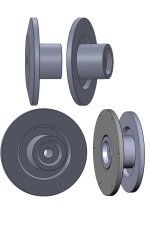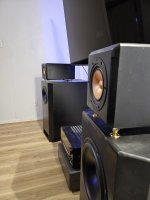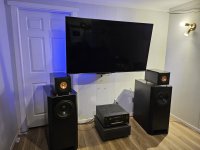Does anyone eq their full ranges? Mine use helper tweeters, and are highpassed at line level to a sub, so its been pointed out to me they aren't really full range speakers.
Now I've settled on reversing polarity to the second order highpassed tweeters, I find the sound has a lot less sibilants, and a glare in some high pitched vocals after equalizing.
For digital sources like streaming, through a couple of different DACs, or an AVR for TV shows or movies.
With a few different phono stages and cartridge combinations, these colorations don't seem to show up.
Anyone else find this happening with different sources?
I'm not saying the different phono playback combinations all sound the same; my meaning is the different sounds aren't egregious.
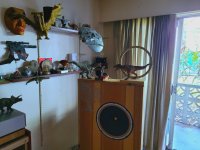
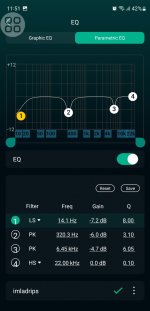
Now I've settled on reversing polarity to the second order highpassed tweeters, I find the sound has a lot less sibilants, and a glare in some high pitched vocals after equalizing.
For digital sources like streaming, through a couple of different DACs, or an AVR for TV shows or movies.
With a few different phono stages and cartridge combinations, these colorations don't seem to show up.
Anyone else find this happening with different sources?
I'm not saying the different phono playback combinations all sound the same; my meaning is the different sounds aren't egregious.


Last edited by a moderator:
Neat! Is the foil on the cones, or as cones?Pure fun project but works very well
DIY whizzer cones and sandwich cone
View attachment 1293221
https://www.diyaudio.com/community/threads/show-your-outdoor-fun-loudspeakers.411007/post-7644286
Also, I starred out with single drivers without whizzer cones, and still use them, but my stereo speakers use whizzers.
How do you decide on a whizzer cone diameter and profile?
@MITsound
I got some How to threads:
https://www.diyaudio.com/community/threads/how-to-make-a-loudspeaker-sandwich-cone.402917/
https://www.diyaudio.com/community/threads/how-to-make-a-whizzer-cone.398063/
I keep it simple, watch my thread which material I use for the whizzers
I got some How to threads:
https://www.diyaudio.com/community/threads/how-to-make-a-loudspeaker-sandwich-cone.402917/
https://www.diyaudio.com/community/threads/how-to-make-a-whizzer-cone.398063/
I keep it simple, watch my thread which material I use for the whizzers
Thanks. I just find it odd that the digital playback needs the same eq across mediums, and the phono does not, with different front ends.
Wow high-fidelity surrounds. I got pretty good bass extension from the FE108eΣ in my 6L TLonken (made for another driver) -- just a cab like yours with an L-shaped divider behind/below the driver like an angled seat, then another horizontal divider, forming a highly-tapered/stepped TL line. (Reinforced cardboard.)I found a pair of favored, and just lightly used, Fostex FE108EZ 4" full range drivers and bought them. I've begun expansion of the Nest Music Theater to 5.1.2 and need ear-level surrounds. I built a pair of ~5 liter miniOnkens from 15mm Baltic birch remnants from prior builds. These keen tiny full range speakers are awesome from 70Hz-15KHz, despite perfection requiring a much larger horn or transmission line cabinet (which'd be inappropriate for the surrounds locations). The full build & 5.1.2 story is HERE if you wanna wade it.
View attachment 1293135
Does anyone eq their full ranges? Mine use helper tweeters, and are highpassed at line level to a sub, so its been pointed out to me they aren't really full range speakers.
I use 3 primary sources: digital (mostly higher rez FLAC) YouTube (Opus), and vinyl. I've tried to optimize EQ for each medium and for me there is not much difference, so I've blown it off; "it's not egregious." I have not rolled phono cartridges. For me the EQ is more about the drivers/enclosures and the room than the source medium. Yet, if the source sucks, you can't EQ in goodness anyway. I do find that my minagere of gear requires I use a delay injector to correct for the differences in processing time spent in pieces on different audio paths (only digital realm stuff). I even have a path now sending vinyl through a (gasp) pro A>D to compare its naked playing to one EQed. Maybe I should just dump the vinyl as the digital always wins bakeoffs, for me and guests.Anyone else find this happening with different sources?
Yes. I agree there is goodness in the center, back, and above ~ whether derived from 2 ch or discrete multi-ch. While I strongly favor single driver, dynamic, full range speakers in all those spots, I will vary the designs to meet space and location needs, but all are/will be full range hifi made from scratch.After replacing them as fronts, after a few weeks of non use I put my Mark Audio 12P pair in as surrounds in my AV system.
I was really surprised how much more goes on there than I had thought.
Wow high-fidelity surrounds.
Yes. I'm almost gave up, the most expensive part is magnet structure, to be honest I;m getting trouble finding the right material with less than 0.15% carbon, Armco might be ideal but hard to get in my country, looking curently for something not soo expensive but with less than 0.2% CAs that suggests to me the frame is assembled in several layers (bezel/mounting bracket, motor support frame, motor/magnet assembly), perhaps you mean collapsible?
Anyways, enough pedantry for now.
Last edited by a moderator:
Hi there,
started as a test for a question in this forum about the interaction of a front loaded horn as waveguide for a fullrange speaker with a whizzer cone
https://www.diyaudio.com/community/...how-does-that-work-with-whizzer-cones.410910/
i think i will keep it for a while for my home office room

Fullrange and subwoofer technology
21 inch chassis with almost no baffle needs massive PEQ for bass
the waveguide makes a problem with a dip at 5 kHz on axis that goes away off axis
BW4 250 Hz with miniDSP 2X4 HD and PEQ for FR linearization measured about 30 degree off axis CLIO pocket measurement plot
microphone distance about 50 cm - 20 inch

started as a test for a question in this forum about the interaction of a front loaded horn as waveguide for a fullrange speaker with a whizzer cone
https://www.diyaudio.com/community/...how-does-that-work-with-whizzer-cones.410910/
i think i will keep it for a while for my home office room
Fullrange and subwoofer technology
21 inch chassis with almost no baffle needs massive PEQ for bass
the waveguide makes a problem with a dip at 5 kHz on axis that goes away off axis
BW4 250 Hz with miniDSP 2X4 HD and PEQ for FR linearization measured about 30 degree off axis CLIO pocket measurement plot
microphone distance about 50 cm - 20 inch
My foot-of-bed diystudio. Up-firing vintage Alnico 8" over stylish trashcan. The waveguide (tissue roll center) really flattens out mid-hi response and widens directivity; tonality is just right. Image floats midair beyond speakers/wall. Really no complaints, difficult to turn off music. (1st-gen Huawei P10plus streaming Baidu cloud, my EAC-rip/hdtracks/etc multi-T library. Ancient iPadPro records nicely too. OCC interconnect a must. TPA3221-on-steroids. Close enough to my earlier "retreat" system: highly tweaked musicPC/fb2k, Chord Hugo, Bel Canto, Monitor Audio Studio etc.)


It IS pretty great when you get things right for your own tastes. Today I'm back to a modest 6SN7 based linestage, with a 12AX7 based phonostage, both with non exotic Raytheon tubes, along with a little NOS DAC.
Serendipity allows me to set aside the tweeters I had helping my 12" single driver speakers.
Some audio friends are telling me I need more treble extension, but I like it.
The music isn't so much launched at me; it just slides open the door and invites me in. Free at last.

Serendipity allows me to set aside the tweeters I had helping my 12" single driver speakers.
Some audio friends are telling me I need more treble extension, but I like it.
The music isn't so much launched at me; it just slides open the door and invites me in. Free at last.
Nice room - love the choice of displayed vinyl covers 🙂
Here is my Fostex FE167e Chilli Chang build.... Driven off my DIY Son of Xen (Son of Zen v6). (The SoX is another post altogether!)
Spectacular sound. Beautifully, subtlely extended in the low end and prefectly balanced throughout. Very little Fostex shout thank you!
Using super-tweeters as well now on top of the cabinets (not shown in the pics). There is no identifiable sweet-spot in the room - sounds fantastic wherever you are which was my intention.
So glad I had these drivers to re-purpose from an old t-line build - and run-in, too... they're are like hen's teeth now!
Here is my Fostex FE167e Chilli Chang build.... Driven off my DIY Son of Xen (Son of Zen v6). (The SoX is another post altogether!)
Spectacular sound. Beautifully, subtlely extended in the low end and prefectly balanced throughout. Very little Fostex shout thank you!
Using super-tweeters as well now on top of the cabinets (not shown in the pics). There is no identifiable sweet-spot in the room - sounds fantastic wherever you are which was my intention.
So glad I had these drivers to re-purpose from an old t-line build - and run-in, too... they're are like hen's teeth now!
Attachments
Hello all. I'm awaiting delivery for a matching to my stereo pair open baffle bass panel. In the meanwhile, I'm trying out an Energy sub. It's in use with an external plate amp, since its og one's transformer burned up.
Since I don't know if its stock amp has eq built in to assist its port, I used my plate amp eq for a wide Q cut at -14db at 20 hertz, as its rated down to 32 hz or so.
Bass is more nuanced (nimble?) with this, especially bass guitar, acoustic and electric.
Using the vertical and longest horizontal lengths of my living room, I calculated the longest hypotenuse to get the longest axis for the longest bass wavelength which fits without being crumpled, and I get 43hz.
So I kept the Q the same and raised the cutoff frequency to about 28 hz.
Another improvement in clarity, although with some Sci fi movies, deep rumbles or fx are lessened noticeably.
So my room will support bass below the length of the longest wavelength which fits, but more as pressure than a recognizable soundwave?
I have no way of getting a graph of this.
Has anyone here done this?

Since I don't know if its stock amp has eq built in to assist its port, I used my plate amp eq for a wide Q cut at -14db at 20 hertz, as its rated down to 32 hz or so.
Bass is more nuanced (nimble?) with this, especially bass guitar, acoustic and electric.
Using the vertical and longest horizontal lengths of my living room, I calculated the longest hypotenuse to get the longest axis for the longest bass wavelength which fits without being crumpled, and I get 43hz.
So I kept the Q the same and raised the cutoff frequency to about 28 hz.
Another improvement in clarity, although with some Sci fi movies, deep rumbles or fx are lessened noticeably.
So my room will support bass below the length of the longest wavelength which fits, but more as pressure than a recognizable soundwave?
I have no way of getting a graph of this.
Has anyone here done this?
I used twelve Fountek 3.5" full range drivers in this Shaded Array / Constant Beamwidth Transducer based on Don Keele's work. 35Hz-25KHz, high output, 9 octaves bandwidth.
Full technical details in this thread: https://www.diyaudio.com/community/...e-drivers-with-35hz-25khz-high-output.412154/

The thing I'm most proud of is the RC network that shades the signal to each of the 12 drivers differently, which is a solid family of curves. It ensures that all 12 drivers equally share the bass load below 100Hz while shifting the treble to the lower drivers to achieve the desired polar pattern above 500Hz. This also eliminates most of the comb filtering that you get with arrays:

Complete tech details here.
Full technical details in this thread: https://www.diyaudio.com/community/...e-drivers-with-35hz-25khz-high-output.412154/
The thing I'm most proud of is the RC network that shades the signal to each of the 12 drivers differently, which is a solid family of curves. It ensures that all 12 drivers equally share the bass load below 100Hz while shifting the treble to the lower drivers to achieve the desired polar pattern above 500Hz. This also eliminates most of the comb filtering that you get with arrays:
Complete tech details here.
Last edited:
I find my rising top end a little harsh so I've added a slight slop starting at 9k, other than that my alpair 10.3s do great until they get lower so I went with a fast tower setup, the full ranges cover everything above 300 so they still have their point source magic. But yeah I agree most full range speakers could use some help, with that said they are super easy to pair with other drivers, cool buildDoes anyone eq their full ranges? Mine use helper tweeters, and are highpassed at line level to a sub, so its been pointed out to me they aren't really full range speakers.
Now I've settled on reversing polarity to the second order highpassed tweeters, I find the sound has a lot less sibilants, and a glare in some high pitched vocals after equalizing.
For digital sources like streaming, through a couple of different DACs, or an AVR for TV shows or movies.
With a few different phono stages and cartridge combinations, these colorations don't seem to show up.
Anyone else find this happening with different sources?
I'm not saying the different phono playback combinations all sound the same; my meaning is the different sounds aren't egregious.
View attachment 1293248
Attachments
@perrymarshall
Is the shaded array acoustially much superior to the classic line driver array?
Isn't the curved array already better than the straight line driver array?
Is the shaded array acoustially much superior to the classic line driver array?
Isn't the curved array already better than the straight line driver array?
The shaded array is definitely superior. It has much less comb filtering; and if you go to my original post and click on the links to Don Keele‘s website, it explains it in great detail.
http://www.xlrtechs.com/dbkeele.com/CBT.php
Curved arrays are better than straight arrays, that’s why you see them in all kinds of concert venues.
http://www.xlrtechs.com/dbkeele.com/CBT.php
Curved arrays are better than straight arrays, that’s why you see them in all kinds of concert venues.
- Home
- Loudspeakers
- Full Range
- Full Range Speaker Photo Gallery
![DSC_0039[1].JPG](/community/data/attachments/1206/1206518-81547a82fffba4567140652b555ea72f.jpg?hash=gVR6gv_7pF)
![DSC_0041[1].JPG](/community/data/attachments/1206/1206519-c7ceb52851fabf58578cd9c2641d5344.jpg?hash=x861KFH6v1)
![DSC_0049[1].JPG](/community/data/attachments/1206/1206520-12f934db9422bb504e2df7a92d09c660.jpg?hash=Evk025Qiu1)
![DSC_0052[1].JPG](/community/data/attachments/1206/1206521-7836ba83eb97a0a3d9ad0c66c6af9c9c.jpg?hash=eDa6g-uXoK)
![DSC_0105[1].JPG](/community/data/attachments/1206/1206522-15103d20e3ed2c9ab2e3c1d87a2aab75.jpg?hash=FRA9IOPtLJ)
